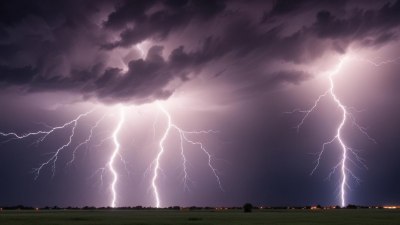What the Color of Clouds Reveals About the Storm Brewing Above
Discover how cloud colors indicate different weather patterns and storm intensity.

This image was created with the assistance of Freepik
The sky can tell us a lot about the weather, particularly when it comes to the color of clouds. Observing the hues of these clouds can provide valuable insight into whether a storm is brewing, its potential intensity, and the types of weather we might expect. The phenomenon of cloud coloration is related to various atmospheric processes, and understanding these can help us anticipate changes in the weather. In this article, we will explore the different cloud colors, what they signify, and how they can warn us of impending storms.
Cloud Colors and Their Meanings
Clouds can appear in various colors, with the most common being white, gray, and darker shades. Typically, two main factors influence cloud color: the amount of sunlight they reflect and the thickness of the cloud itself. Understanding these factors can provide essential clues about upcoming weather patterns.
White clouds are often associated with fair weather and gentle breezes. These clouds, such as cumulus clouds, are thick enough to reflect sunlight but not so dense as to block it entirely. While white clouds suggest generally pleasant weather, they can also indicate the presence of moisture-laden air, which could lead to precipitation later on.
Gray clouds, on the other hand, can signify overcast conditions and possible rain. When clouds take on a gray hue, it often means they are thicker and contain more moisture. Stratus clouds, which appear as uniform gray layers, are a prime example of clouds that can bring light rain or drizzle. The deeper the gray, the more moisture they hold, indicating that rain may not be far away.
The Role of Thickness and Density
Another significant factor in determining cloud color is thickness and density. Thick, dark clouds, such as nimbostratus, indicate steady and prolonged rain. These clouds are dense and low-lying, often covering the sky in a blanket that can lead to a drizzly day. Observers often note that as nimbostratus clouds build, they can create a sense of heaviness in the atmosphere.
Cumulonimbus clouds are another type of cloud associated with storms. These towering giants can reach heights of over 10,000 meters and often exhibit a very dark color at their base. When you see a dark cumulonimbus cloud, it is a strong warning sign of severe weather, including heavy rain, thunderstorms, and even tornadoes. The dark appearance is due to the immense amount of moisture and ice particles that absorb sunlight.
Rainbow Hues and Atmospheric Conditions
Interestingly, clouds can also display shades of yellow, red, and even purple under certain conditions. These colors arise mainly during sunrise and sunset when the angle of the sun scatters light through the atmosphere. If a storm is approaching during these times, observers may notice particularly vibrant colors, signifying a potential weather change.
Yellow or orange clouds often indicate the possibility of a storm on the horizon. The color results from sunlight illuminating the edges of thick clouds, which can be an early warning signal for those watching closely. The phenomenon of 'light pollution' in urban areas can exaggerate these colors, making them appear even more vivid.
Understanding Storm Severity
By interpreting cloud colors, we can also gauge the intensity of a storm. Darker clouds typically indicate stronger storms with higher precipitation, while lighter shades may signify less severe weather. Local meteorological services often use these observations in conjunction with advanced forecasting technologies to provide accurate weather updates.
For example, if meteorologists observe a large formation of dark cumulonimbus clouds moving into an area, they may issue severe weather alerts, including tornado watches or flash flood warnings. This emphasizes the importance of paying attention to clouds and their colors before a storm strikes.
How to Observe and Interpret Cloud Colors
To become an effective observer of cloud colors, it's essential to understand how to observe the sky accurately. Spend some time monitoring the clouds daily. Take note of their shapes, colors, and any changes that occur over time. By doing so, you will begin to identify patterns that correspond with weather changes.
It is advisable to carry a camera or a smartphone to take pictures of clouds. This valuable reference can help you compare different cloud types and colors over time. Joining local meteorology clubs or online forums can provide additional insights as well, as you may learn from experienced weather enthusiasts about interpreting cloud conditions.
The Science Behind Cloud Coloration
As we dive deeper into the science of cloud coloration, it is essential to recognize that cloud colors result from the scattering of light. Rayleigh scattering and Mie scattering are two phenomena contributing to the colors we see in the sky. Rayleigh scattering occurs when sunlight interacts with particles smaller than the wavelength of light, typically resulting in blue skies. In contrast, Mie scattering operates with larger particles, causing clouds to appear gray or white.
When clouds are thick and full of moisture, more photons are scattered, leading to darker hues. Observing the interaction of sunlight with cloud attributes aids in comprehending why some clouds seem brighter than others, even during similar weather conditions.
Limitations of Cloud Color Interpretation
While cloud color can provide valuable insight into weather patterns, it is not always reliable as an isolated predictor of storms. Environmental factors such as pollution, humidity, and local topography can also alter cloud appearance. Sometimes, local anomalies may produce unusual colors in clouds that do not accurately represent weather conditions.
Therefore, it is crucial to integrate cloud observation with other weather data, including temperature, humidity, and atmospheric pressure, to develop a comprehensive understanding of potential storm systems. Moreover, relying solely on cloud colors can lead to inaccurate forecasting, as weather patterns are influenced by numerous variables.
Cloud Colors as Weather Predictors
In summary, cloud colors play an integral role in weather observation and storm prediction. Recognizing what different colors signify can empower individuals to understand weather changes and respond appropriately. While it is not a definitive science, understanding cloud colors provides an essential tool for anticipating storm development.
As we continue to explore the beauty and complexity of our atmosphere, we can enhance our appreciation of the cues nature provides. Whether it’s a beautiful sunset casting orange and pink hues across the horizon or ominous gray clouds loading up with rain, each cloud tells a story. By becoming more aware of the colors above, we can better prepare for whatever weather lies ahead.











